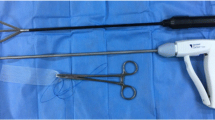Abstract
Introduction and hypothesis
The aim of this study was to compare abdominal sacrocolpopexy (ASCP) with posterior intravaginal slingoplasty (PIVS) in terms of lower urinary tract symptoms and anatomical restoration.
Methods
Ninety-two patients underwent PIVS and 98 patients underwent ASCP.
Results
Regarding ASCP, the blood loss, operation time, and hospitalization length were 537 ml, 94.5 min, and 3.07 days, respectively. Eight (8) patients required blood transfusion; urinary retention was diagnosed in four cases, surgical side infection was seen in three cases; constipation was a problem in nine cases; retroperitoneal haematoma was observed in one case; and bladder injury happened in two cases. Regarding PIVS, the blood loss, operation time, and hospitalization length were 275 ml, 53 min, and 2.08 days, respectively. Intramuscular haematoma was diagnosed in one patient, and constipation was a problem in one patient.
Conclusions
ASCP and PIVS had same efficiency for the treatment of vault prolapse during the study follow-up. Both operations had good anatomical restoration for rectocele and cystocele. Moreover, PIVS also cured enterocele as an additional advantageous over ASCP. Besides, PIVS has significantly improved stress urinary incontinence, nocturia, and pelvic pain in terms of lower urinary tract symptoms compared to ASCP.

Similar content being viewed by others
References
Marchionni M, Bracco GL, Checcucci V et al (1999) The true incidence of vaginal vault prolapse. Thirteen years of experience. J Reprod Med 44(8):679–684
Petros PE (2001) Vault prolapse II: restoration of dynamic vaginal supports by infracoccygeal sacropexy, an axial day-case vaginal procedure. Int Urogynecol J Pelvic Floor Dysfunct 12(5):296–303
Karram MM, Sze EHM, Walters MD (1999) Surgical treatment of vaginal vault prolapsed. In: Karram MM, Walters MD (eds) Urogynecology and reconstructive pelvic surgery. Mosby, St. Louis, pp 235–256
Brubaker L, Cundiff GW, Fine P et al (2006) Abdominal sacrocolpopexy with Burch colposuspension to reduce urinary stress incontinence. N Engl J Med 354:1557–1566
Baden WF, Walker TA (1992) Genesis of the vaginal profile: a correlated classification of vaginal relaxation. Clin Obstet Gynecol 15(4):1048–1054
Cam C, Sakalli M, Ay P, Cam N, Karateke A (2007) Validation of the short forms of the incontinence impact questionnaire (IIQ-7) and the urogenital distress inventory (UDI-6) in a Turkish population. Neurourol Urodyn 26:129–133
Sivaslioglu AA, Gelisen O, Dolen I et al (2005) Posterior sling (infracoccygeal sacropexy): an alternative procedure for vaginal vault prolapse. Aust New Zeal J Obstet Gynaecol 45:159–160
Petros PE (1997) New ambulatory surgical methods using an anatomical classification of urinary dysfunction improve stress, urge and abnormal emptying. Int Urogynecol J 8:270–278
Oliver R, Dasgupta C, Coker A (2006) Posterior intravaginal slingplasty for vault and uterovaginal prolapse: an initial experience. Gynecol Surg 3:88–92
Nygaard IE, McCreery R, Brubaker L et al (2004) Abdominal sacrocolpopexy: a comprehensive review. Obstet Gynecol 104:805–823, Abdo sacro anaotomic outcomes
Brubaker L, Nygaard I, Richter HE et al (2008) Two year outcomes after sacrocolpopexy with or without Burch to prevent stress urinary incontinence. Obstet Gynecol 112(1):49–55
Farnsworth B (2007) Posterior IVS for vault suspension: a re-evaluation. Pelviperineology 26:70–72
Neuman M, Lavy Y (2007) Conservation of the prolapsed uterus is a valid option: medium term results of a prospective study with the posterior intravaginal slingoplasty operation. Int Urogynecol J Pelvic Floor Dysfunct 18:889–993
SivasliogluAA UE, Dolen İ (2008) The multifilament polypropylene tape erosion trouble: tape structure vs. surgical technique. Which one is the cause? Int Urogynecol J 19:417–420
Kohli N, Walsh PM, Roat TW, Karram MM (1998) Mesh erosion after abdominal sacrocolpopexy. Obstet Gynecol 92:999–1004
Conflicts of interest
None.
Author information
Authors and Affiliations
Corresponding author
Rights and permissions
About this article
Cite this article
Sivaslioglu, A.A., İlhan, T.T., Aydogmus, S. et al. The comparison of the anatomical and symptomatic outcomes of sacrocolpopexy and posterior intravaginal slingoplasty. Int Urogynecol J 22, 1363–1368 (2011). https://doi.org/10.1007/s00192-011-1442-z
Received:
Accepted:
Published:
Issue Date:
DOI: https://doi.org/10.1007/s00192-011-1442-z




